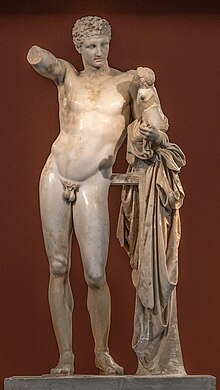
Back Hermes və körpə Dionis Azerbaijani Хермес с детето Дионис Bulgarian Hermes amb Dionís infant Catalan Hermés s dítětem Dionýsem Czech Hermes von Olympia German Ερμής του Πραξιτέλη Greek Hermes con el niño Dioniso Spanish Praksiteleen Hermes Finnish Hermès portant Dionysos enfant French Hermes co neno Dioniso Galician

Hermes and the Infant Dionysus, also known as the Hermes of Praxiteles or the Hermes of Olympia is an ancient Greek sculpture of Hermes and the infant Dionysus discovered in 1877 in the ruins of the Temple of Hera, Olympia, in Greece. It is displayed at the Archaeological Museum of Olympia.
It is traditionally attributed to Praxiteles and dated to the 4th century BC, based on a remark by the 2nd century Greek traveller Pausanias, and has made a major contribution to the definition of Praxitelean style. Its attribution is, however, the object of fierce controversy among art historians.[clarification needed][citation needed]
The sculpture is unlikely to have been one of Praxiteles' famous works, as no ancient replicas of it have been identified. The documentary evidence associating the work with Praxiteles is based on a passing mention by the 2nd century AD traveller Pausanias.